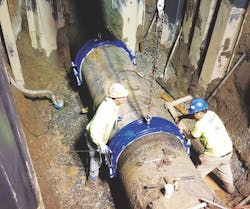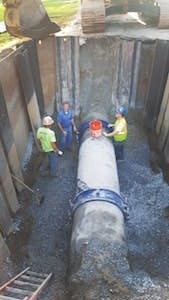About the author:
Kevin Looby is a territory sales manager for Krausz USA. Looby can be reached at 352.789.9552.
East Greenbush, N.Y., is a town of approximately 15,000 residents where Tom Kennedy serves as the East Greenbush Water Department general foreman. The municipality purchases its water from nearby Troy, N.Y.; the water is distributed through 10 miles of 36-in. ductile iron pipe to two 5-million-gal tanks.
Originally installed in 1964, the ductile pipe has been deteriorating due to age, with breaks becoming increasingly common. Most recently, Kennedy found that repairs needed to be made about twice a year; twenty years ago, it was only once a year.
The Situation
In 2011, Kennedy needed to fix a pipe that required a section to be cut out, replaced and connected with two traditional 36-in. couplings. These couplings had multiple bolts to tighten and required digging under the pipe to allow space for crew members to lie on their backs and tighten the lower bolts.
The repair held until January 2016, when the multi-bolt coupling started to leak. Under difficult winter conditions, Kennedy and his crew excavated the pipe and retightened the bolts on one of the couplings. Once fixed, there were no issues until August 2017, when the other end of the same coupling began to leak.
Kennedy needed to minimize downtime to ensure that water service was returned quickly, and wanted the peace of mind that his crew would not have to repeatedly dig up and fix the same connection. After uncovering the pipe and removing the coupling, the crew determined that the end of the pipe was not perfectly round and required a coupling to accommodate its slightly oval shape.
“We did not want to have a situation where we would have to come back to the pipe to do another repair in a few years,” Kennedy said. “We wanted a solution that would be permanent and durable enough to withstand ground movement caused by changes in temperature. This is the only 36-in. transmission main that feeds our two 5-million-gal tanks that supply water to our businesses and residents.”
Connecting the Ends
Kennedy decided to replace the old coupling entirely rather than retighten the bolts, as he had done at the other end of the section replacement. He wanted to use a new coupling, given the problems with the one used to make the original repair in 2011. Kennedy’s crew removed the old coupling and reattached the pipe to the main line with a Hymax large-diameter (HLD) 36-in. coupling.
The coupling meets AWWA Standard C-219, and NSF standards 61 and 372. The end and center rings are made of grade C steel with gaskets available in EPDM, and are compounded for water and sewage. They meet international standards for contact with drinking water. The bridge and spherical spacers are made of stainless steel, while the coupling is coated with 100% fusion-bonded epoxy for enhanced corrosion protection. Nuts and bolts also are made of stainless steel with a rolled thread. These bolts go through a dry treatment process called molecular anti-galling (MAG) based on embedded zinc. MAG eliminates the need to grease bolts and reduces wear from the effects of dirt and sand to prevent galling and enable repeated tightening.
Large-diameter couplings can fit many different sizes of pipe and were especially helpful in East Greenbush, N.Y., where the pipes were not perfectly round.
The Selection
Kennedy chose Hymax for four reasons, ranging from ease of maintenance to durability.
1. Only four top-facing bolts to tighten. Compared to as many as 18 bolts in other 36-in. couplings, Hymax has only four top-facing bolts to tighten. That allowed Kennedy’s crew to quickly install the coupling without digging under the pipe for space to tighten the bolts. With fewer bolts to tighten, crews spend less time in the ditch, which minimizes safety risks. “When you are in a trench 12 ft deep, you want to get the job done as fast as possible,” Kennedy said. “Lying down under the pipe to tighten bolts is also hard work because there is less leverage to tighten bolts compared to being on your feet. That’s a lot less wear and tear on workers’ bodies, too.”
2. One-piece, stab-on design. The couplings feature a one-piece, stab-on design that is simple to install and does not require assembling many different parts. With fewer pieces needed for assembly, complications during installation—such as losing bolts in the mud—are kept to a minimum.
3. Fits a wide range of pipe sizes. HLDs have a range of 2.1 in. and can connect pipes for a variety of materials. Most couplings are range-dedicated and limited to a single pipe size. With a greater range, installers have flexibility to make repairs as they uncover pipes of varying sizes in the ditch. Because the pipe Kennedy sought to connect was not perfectly round, the range was advantageous. “With other couplings that we’ve used, there wasn’t much leeway with any deviation in size or if the shape of the pipe wasn’t perfectly round,” Kennedy said. “With the Hymax, it wasn’t a problem to connect the oval-shaped pipe to the coupling with a strong, secure fit.”
4. Durable and dynamic. The large-diameter couplings are durable and offered a long-term repair solution because they can absorb dynamic pipe deflection of up to 4 degrees on each end. This allows the coupling to absorb pressure on the pipe due to shifting ground or changing temperatures, and can reduce the risk of damage and cracking while saving resources on future pipe repairs.
Conclusion
The coupling’s features helped Kennedy to quickly make the repair and ensure that it remains durable.
Just as important, however, was the fact that the large-diameter coupling was simple and easy to install. With four top-facing bolts, workers did not have to dig under the pipe or lie under it to tighten bolts. The one-piece, stab-on design also made the coupling easy to install. Finally, the wide range of the coupling meant that it could more easily fit pipes that were not perfectly round, such as those requiring repair in Kennedy’s situation.
“At the end of the day, it’s about reliability and getting the job done right,” Kennedy said. “When you have a way to make a repair quickly, and have it secure and durable at the same time, it makes the choice pretty clear and simple.”

